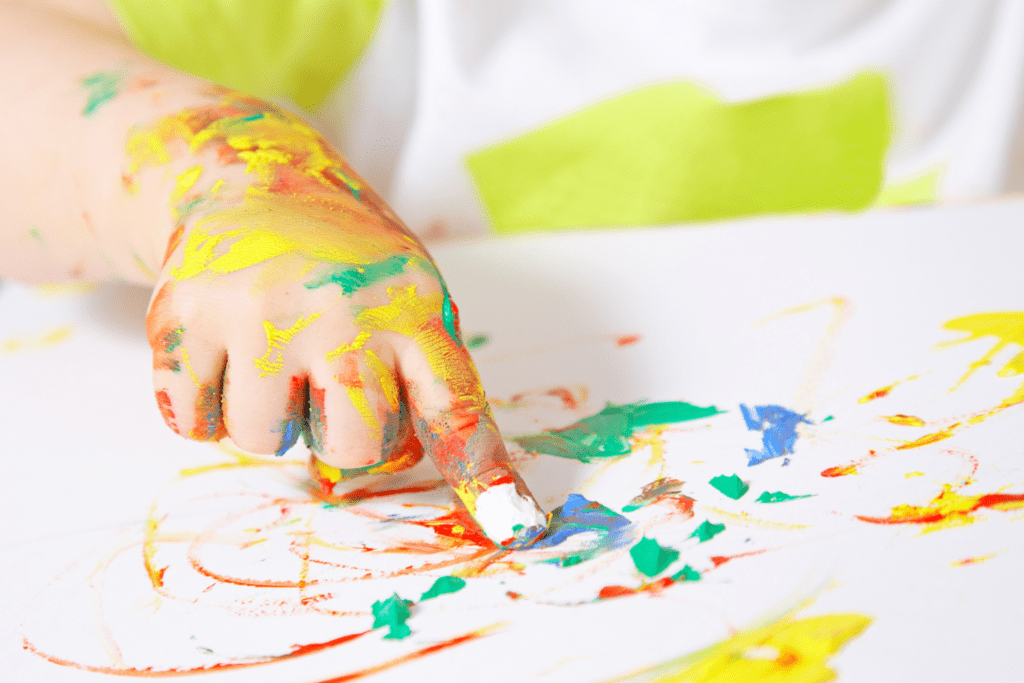This post contains affiliate links, meaning, at no additional cost to you, if you click through and make a purchase, I may receive a commission. I only share items that I truly love and use myself. For more information please see my disclosures here.
Be sure to listen to the
She’s Got It Together Podcast!
10 Fun and Educational Activities for Toddlers at Home
Keeping toddlers entertained can feel like a full-time job, right? With their endless energy and curious minds, it’s essential to find activities that are not only fun but also educational. Whether you’re stuck indoors on a rainy day or just looking for new ways to keep your little one engaged, we’ve got you covered. Let’s dive into some awesome toddler activities at home that promote learning and development!
1. DIY Sensory Bins
Sensory bins are a fantastic way to engage your toddler’s senses. Fill a bin with different textures like rice, beans, or pasta, and add small toys or objects for them to explore. You can even theme your sensory bins based on colors, seasons, or holidays.
How to Create a Sensory Bin:
- Choose a Base: Start with a base material like uncooked rice, dried beans, sand, or pasta. You can even use water or ice cubes for a different sensory experience.
- Add Items: Include small toys, spoons, cups, and objects related to your theme. For example, if you choose an ocean theme, add toy fish, seashells, and blue-colored items.
- Tools: Provide tools like tongs, scoops, and small containers for pouring and sorting.
Benefits: Sensory play helps with cognitive growth, fine motor skills, and language development as you talk about what they’re experiencing. It also promotes independent play, allowing your child to explore and learn at their own pace.
Extended Play Ideas:
- Color Sorting: Add colored items to the bin and encourage your toddler to sort them by color.
- Hide and Seek: Hide small toys in the bin and ask your child to find them.
- Texture Exploration: Mix different textures together and let your child describe how they feel.
2. Story Time Adventures
Reading to your toddler is one of the best activities you can do. Take it up a notch by acting out the stories or using different voices for characters. You can even create a cozy reading nook with blankets and pillows to make it extra special.
Creating a Cozy Reading Nook:
- Comfortable Seating: Use bean bags, cushions, or a soft chair.
- Lighting: Add a small lamp or fairy lights for a warm, inviting glow.
- Books: Keep a variety of age-appropriate books within reach. Rotate them regularly to keep your toddler interested.
Benefits: Enhances language skills, imagination, and a love for reading. It also strengthens the parent-child bond through shared time and interaction.
Extended Reading Activities:
- Story Acting: Encourage your toddler to act out their favorite parts of the story.
- Drawing Scenes: After reading, let your child draw their favorite scenes or characters.
- Question Time: Ask questions about the story to develop comprehension skills.
3. Indoor Obstacle Course
Turn your living room into a fun obstacle course! Use cushions, chairs, and blankets to create tunnels, climbing areas, and jump spots. This is a great way to burn off some of that toddler energy.
Setting Up an Indoor Obstacle Course:
- Plan Your Course: Decide on the start and end points. Include various obstacles like crawling under tables, jumping over pillows, and climbing over cushions.
- Clear Space: Make sure the area is safe and free from sharp objects or fragile items.
- Guide and Encourage: Demonstrate each part of the course and cheer your toddler on as they navigate through it.
Benefits: Improves gross motor skills, balance, and coordination. It also promotes problem-solving and following instructions.
Extended Play Ideas:
- Time Trials: Use a stopwatch to time how long it takes to complete the course.
- Themed Courses: Create themes like a jungle adventure or a superhero training camp.
- Obstacle Variations: Change up the obstacles regularly to keep the activity fresh and challenging.
4. Homemade Playdough
Making playdough at home is easy and fun! Plus, it’s a great activity for toddlers to help with. Use simple ingredients like flour, salt, water, and food coloring. Once it’s ready, let your toddler’s creativity run wild as they mold and shape their creations.
Simple Playdough Recipe:
- Ingredients: 2 cups flour, 1 cup salt, 1 cup water, 1 tablespoon vegetable oil, food coloring.
- Instructions: Mix the dry ingredients together. Gradually add water and oil while stirring. Knead the dough until smooth. Add food coloring and mix until evenly distributed.
Benefits: Enhances fine motor skills, creativity, and sensory development. It’s also a great way to introduce basic math and science concepts through measuring and mixing.
Extended Play Ideas:
- Themed Playdough: Create themed playdough sets like making shapes with cookie cutters or building small animals.
- Playdough Tools: Use rolling pins, plastic knives, and molds to enhance the play experience.
- Playdough Games: Incorporate games like “find the hidden toy” or “make a matching pair.”
5. Nature Scavenger Hunt
If the weather is nice, take your toddler on a nature scavenger hunt in your backyard or a nearby park. Make a list of items to find, like leaves, rocks, flowers, and insects.
How to Organize a Nature Scavenger Hunt:
- Create a List: Make a simple list of items for your toddler to find. Include pictures if your child isn’t reading yet.
- Collecting Tools: Give your child a small bag or bucket to collect their treasures.
- Explore Together: Walk around with your child, helping them find and identify each item.
Benefits: Encourages outdoor exploration, observation skills, and a connection to nature. It also provides physical exercise and fresh air.
Extended Play Ideas:
- Nature Art: Use collected items to create nature art projects like leaf rubbings or rock paintings.
- Storytelling: Create stories based on the items found during the hunt.
- Nature Journal: Help your child create a nature journal to document their finds with drawings and descriptions.
6. Music and Dance Party
Put on some tunes and have a dance party! Use simple instruments like tambourines, shakers, or even pots and pans to create a mini band. Dancing and making music are great ways to get moving and have fun together.
Setting Up a Music and Dance Party:
- Music Selection: Choose a variety of music that your toddler enjoys. Include songs with different tempos and rhythms.
- Instruments: Provide simple instruments or make your own using household items. Encourage your child to experiment with different sounds.
- Dance Space: Clear an area for dancing. Show your child some basic dance moves and let them create their own.
Benefits: Develops rhythm, coordination, and listening skills. It also promotes physical activity and creativity.
Extended Play Ideas:
- Freeze Dance: Play a game where everyone freezes when the music stops.
- Parade: Have a mini parade around the house with instruments and dancing.
- Songwriting: Encourage your child to make up their own songs and perform them.
7. Simple Science Experiments
Introduce your toddler to the world of science with easy experiments. Try mixing baking soda and vinegar to create a fizzy reaction or make a rainbow with a glass of water and a flashlight.
Fun Science Experiments for Toddlers:
- Baking Soda and Vinegar: Place baking soda in a container and add vinegar for a fizzy reaction. Add food coloring for extra fun.
- Rainbow Creation: Shine a flashlight through a glass of water to create a rainbow on a piece of white paper.
- Float and Sink: Fill a tub with water and let your child predict which items will float or sink.
Benefits: Sparks curiosity, understanding of cause and effect, and basic scientific concepts. It also promotes critical thinking and observation skills.
Extended Play Ideas:
- Nature Science: Explore nature-based science like watching ants, planting seeds, or examining leaves.
- Kitchen Science: Conduct simple experiments with kitchen items, like making ice cream in a bag or creating slime.
- Building Projects: Use blocks or other materials to build structures and explore balance and stability.
8. Art and Craft Time
Get crafty with your toddler using safe, non-toxic materials. Finger painting, drawing with crayons, and making collages with paper and glue are all great options. Display their artwork proudly to boost their confidence.
Craft Ideas for Toddlers:
- Finger Painting: Use washable paints and let your child create colorful masterpieces with their fingers.
- Collages: Provide paper, glue, and various materials like tissue paper, buttons, and fabric scraps for your child to create collages.
- Drawing and Coloring: Set up a drawing station with crayons, markers, and paper.
Benefits: Enhances creativity, fine motor skills, and self-expression. It also provides a sense of accomplishment and boosts self-esteem.
Extended Play Ideas:
- Themed Art Projects: Create art based on themes like holidays, seasons, or favorite animals.
- Story Art: Encourage your child to draw pictures that tell a story.
- Art Shows: Organize a mini art show at home where your child can display and talk about their artwork.
9. Sorting Games
Use household items like buttons, blocks, or socks to create sorting games. Ask your toddler to sort by color, size, or shape. This activity is simple but highly effective.
How to Play Sorting Games:
- Select Items: Choose a variety of items that can be sorted in different ways. Ensure they are safe and appropriate for your child’s age.
- Create Categories: Show your child how to sort the items into different categories. Start with simple categories like colors and shapes.
- Encourage Independence: Let your child sort the items on their own, offering guidance as needed.
Benefits: Develops categorization skills, hand-eye coordination, and attention to detail. It also promotes problem-solving and independent play.
Extended Play Ideas:
- Sorting Challenges: Increase the difficulty by adding more categories or mixing similar items.
- Matching Games: Create matching games where your child pairs similar items.
- Sorting Stories: Create stories around the sorted items to enhance learning and engagement.
10. Pretend Play
Encourage your toddler’s imagination with pretend play. Set up a mini kitchen, doctor’s office, or grocery store using household items and toys. Join in the fun and let your toddler take the lead in the game.
Setting Up Pretend Play:
- Mini Kitchen: Use toy food, pots, and pans to create a pretend kitchen. Encourage your child to “cook” meals and serve them.
- Doctor’s Office: Use toy medical kits to set up a pretend doctor’s office. Take turns being the doctor and patient.
- Grocery Store: Set up a pretend grocery store with play food and a shopping cart. Encourage your child to shop for items and check out.
Benefits: Boosts creativity, social skills, and problem-solving abilities. It also helps develop language and communication skills.
Extended Play Ideas:
- Role Play: Encourage your child to take on different roles, like a chef, teacher, or construction worker.
- Story Creation: Use pretend play to create and act out stories together.
- Costume Play: Incorporate costumes and props to enhance the pretend play experience.

Final Thoughts
Engaging your toddler in these fun and educational activities at home can make a big difference in their development. Plus, it’s a wonderful way to bond and create lasting memories. Remember, the goal is to have fun and enjoy the time spent together.


